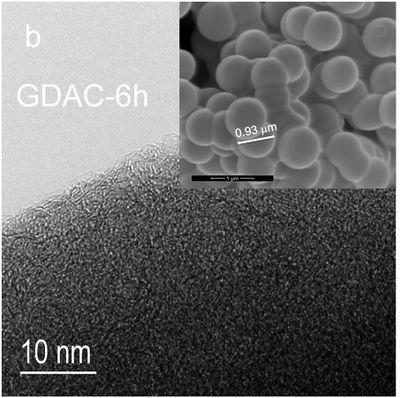Hydrothermal Carbonization: Difference between revisions
Jump to navigation
Jump to search

m (Minor Typo Fix) |
m (Minor Typo Fix) |
||
| Line 15: | Line 15: | ||
=Internal Links= | =Internal Links= | ||
*[[Biochar]] (The term used for using [[Charcoal]] / Bio- [[Petcoke]] or [[Hydrochar]] in soil as a [[ | *[[Biochar]] (The term used for using [[Charcoal]] / Bio- [[Petcoke]] or [[Hydrochar]] in soil as a [[Soil Additive]] such as in [[Synthetic Amazonian Black Earth]] ) | ||
*[[Torrefaction]] | *[[Torrefaction]] | ||
*[[The Biochar Economy]] | *[[The Biochar Economy]] | ||
Revision as of 19:36, 16 September 2024

Carbon nanoballs made from glucose via hydrothermal carbonization, that have been processed with CO2 for 6 hours to change surface properties. SEM image from University of Tartu.
Basics
- Hydrothermal Carbonization (HTC), also known as "hydrochar", is a form of thermal biomass conversion that involves moderate temperatures and pressures over an aqueous solution of biomass in a dilute acid for several hours.
- One advantage of the HTC process over conventional dry-thermal pre-treatments is the ability to handle wet feedstock without pre-drying.
- The resulting "biocoal" can be used as a Fuel or Chemical Feedstock, as a Soil Amendment (similar to biochar), and as a filtration media, among other things
- ’’’As with how Torrefaction is essentially partial Pyrolysis caused by calmer reaction conditions, HTC can be “tuned” to produce Pure Carbon, or something more akin to Lignite
Clarification on Carbon Produced
- ’’’Hydrochar’’’ shall be used as the term for (Near) Pure Amorphous Carbon which is similar to Charcoal , Carbon Black , or Petcoke and can be used as such
- ’’’Bio-Coal’’’ shall be used to refer to Oily Product intended for use as a Solid Fuel akin to Lignite / Bituminous Coal , or as a Chemical Feedstock for products such as Asphaultum (Useful for Japan Black , a durable Metal Coating called Japanning , Humic Acids , or potentially Wax akin to Cerasin Wax , Ozokerite , Motan Wax
Open Source Hardware Needs
- Pressure Vessel
Internal Links
- Biochar (The term used for using Charcoal / Bio- Petcoke or Hydrochar in soil as a Soil Additive such as in Synthetic Amazonian Black Earth )
- Torrefaction
- The Biochar Economy